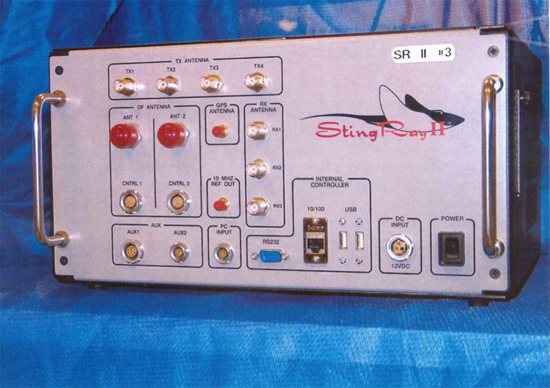University Develops Device That Detects Police Stingray Surveillance
Researchers at the University of Washington have attempted to produce an unprecedented technology. Aiming to shed light on IMSI catchers, aka cell site simulators or “Stingrays”, researchers developed a device that detects possible surveillance activity. Their invention was then field tested in two cities, including Milwaukee.

Cell site simulators, or Stingrays, trickled into police ranks as paramilitarization increased. The sketchy devices mimic cell towers, tricking phones into divulging information. Depending on the model, one stingray can sift thousands of individual devices in a short period of time. Often times, they’re used to track individual’s locations, or monitor messages and calls.
Once exclusive to military or federal agencies, Stingrays now operate even in small local departments. Exactly how many utilize these devices, however, is completely unknown. Even Freedom Of Information Act requests regarding cell site simulator use are often denied.
That secrecy partly comes from strict non-disclosure agreements binding agencies tight. Such documents normally come from private companies producing the Stingrays. Although private entities “trust” clientele will use simulators legally, contracts cover their end. Federal agencies are similarly known to require local counterparts to also sign non-disclosure agreements.
Those few departments concretely linked to Stingray have essentially been caught in the act. In Milwaukee, Wisconsin, police wouldn’t admit how exactly they’d located someone who hadn’t appeared in court. Officers went as far as to claim the info came from “an unknown source”, to the judge’s annoyance. Ultimately, MPD (Milwaukee Police Department) was found to have used a Stingray to find the person and then hid its use.
Subsequent investigations by Wisconsin’s ACLU and others revealed MPD’s Stingrays came from the Harris Corporation. The defense contractor deals in numerous technologies from surveillance to satellite aerospace. As revealed by MPD’s non-disclosure agreement, all requests for IMSI catchers must go through the FBI. This even includes advance warnings in the event MPD thought their tech might get outed. MPD’s document mandated the department not disclose IMSI use to the public, media, and even the courts.
Creative, pioneering solutions are needed if one even hopes to penetrate IMSI’s shadowy domain. That’s where University Of Washington researchers, and they’re detection invention, comes in. The system, dubbed Seaglass – developed by scientists Peter Ney and Ian Smith – is in some ways just as covert as it’s target.
Seaglass was developed specifically to track, and monitor Stingray use throughout a given city. Despite being early phase, both Ney and Smith applaud Seaglass as a monocle to peer past the veil. “We think that Seaglass is a promising technology”, said Ian Smith, “that, with wider deployment, can be used to empower citizens and communities to monitor this type of surveillance.”
Seaglass analyzes cell tower activity via specially designed sensors. Utilizing hot spot generators, cellular modems, a computer and “bait phone”, the sensors are noted as being inexpensive and simple. “Built with off-the-shelf parts”, as Seaglasses website explains, the devices “continuously collect and upload cell tower signal data to a cloud server.” Seaglass sensors can be placed in a car, working as you drive about your city. For their trial, Ney and Smith enlisted the help of Uber drivers.

Data collected by the University Of Washington invention is then plotted on maps located on the Seaglass website. Over two months, Seaglass was field tested in both Seattle and Milwaukee–the author’s home town. In Milwaukee, over 600 cell tower base stations were analyzed by researchers, and 1400 in Seattle.
Of course, there remains a lot of guess work in pin pointing what exact cell towers could be Stingray produced. Researchers closely monitored cell tower strength, unusual channel frequencies, and unexpected spikes in broadcast properties.
However, Seaglass also had to first analyze various aspects of local tower activity and build accurate models. These were then used to spot unusual, unexpected, or unprecedented changes possibly indicating an operational Stingray. You have to build perspective from the ground up and, even then, hoping to find something.
Despite this challenge, researchers not only formed reliable tower models, spotted odd ones out. In one case, a tower was produced significantly stronger signals than a cluster of nearby counterparts. The signal appeared in a map section isolated from the numerous other pings, as displayed on a Seaglass graphic.
In another, a tower cycled through a larger number of channels than the typical 1-3. Although such characteristics were unusual, it’s scientifically difficult to verify whether these were actually Stingrays. If they’re associated with significant landmarks – a Homeland Security Immigration facility in one case – then it boost confidence.
When investigating covert surveillance, it’s best to compile information from as many cases as possible. Perhaps one of the most blatant shows of surveillance state force was the Dakota Access Pipeline (DAPL) protests. Passing months wrought reports of surveillance, device malfunctions, hacking, and similar claims mounted. The widespread phenomenon was shaking enough to persuade even skeptical activists like ex-Baltimore PD Sergeant Michael Wood Jr. In an interview with TFC, even he noted the various malfunctions and “glitches” his group experienced were “highly suspicious”.
Following DAPL’s conclusion, it became known that at least some surveillance was headed by a private contractor. TigerSwan, founded by a former US Army Delta Force operative, is known to have connections with the infamous Blackwater military contracting company. Investigations conducted by The Intercept revealed TigerSwan was involved with electronic surveillance, intelligence gathering through informants, and internal sabotage the DAPL movement.
The nature of surveillance at DAPL should raise spooky questions over what programs exist elsewhere. It’s one thing to track or confirm the use of Stingrays in one city or another. The game completely changes when you ask what they’re doing, who they’re tracking, and for what purpose. How much of their use is actually law enforcement, and how much is outsourced? Seaglass, and its goal to empower citizens, is a unique and spicy development in open source technology.
yogaesoteric
December 22, 2018
